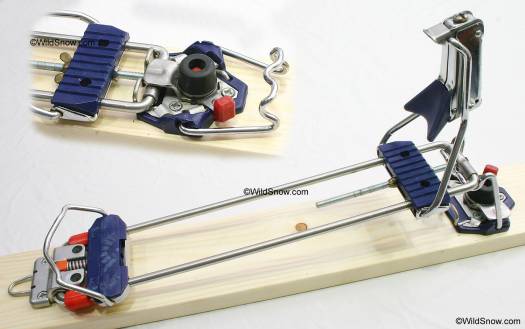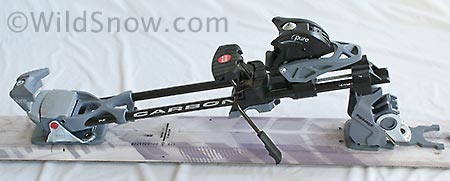Our randonnee binding collection here at WildSnow world headquarters holds a number of interesting classics and antiques. Silvretta 300 is beautiful — a simple and elegant plate binding designed for hard-core alpinism such as climb approaches or ski tours where weight is critical. (Thanks goes to Mark Worley for donating the 300s). To save weight and bulk, the 300 binding didn’t have a lateral (side) safety release. That always seemed a bit iffy to me, but then, just imagine those expert skiing europeans on their short mountaineering skis, flitting about the Alps and beyond. They never fell, so why was release necessary?
Fast forward to 2006. The Pure model line is Silvretta’s state of art offering to the rando world. They are beautiful — and they release. Enjoy these photos comparing old and the new. They both look so tasty I don’t know which one I like best. The Pures are so NOW, but the 300s have a retro mechanico look that’s too sweet. (But don’t worry, the 300s will stay hung on the wall, while the Pures are on snow.) Weights are interesting. The Pure Freeride (their top line model) weighs 28.8 oz 816 g, while the 300 weighs 28.6 oz 810 g (one binding, no screws). Of course you give up side release for the light weight of the 300, but it’s cool that in terms of weight the retro steel of the 80s could match space age plastic and carbon fiber of the millennium.

Silvretta 300 backcountry skiing binding has been available since the 1980s, and is still used for combination climb/ski trips as it works with welted boots, and is relatively light in weight. Not recommended, however, because it has no lateral safety release. I love the retro mechanicals of this machine. Check out the brass wingnut for changing boot length setting. No screwdriver required. Click image for massive enlargement.

New 07/08 Silvretta Pure Freeride is similar to last year’s model but with significant improvements.
Addendum: The Silvretta brand was eventually acquired by Salewa and revived for a short time, while eventually fading and not active in ski gear as of the addendum writing in 2018. The following condensed and edited corporate history is sourced from the now defunct Silvretta website.
“Heinrich Wunder founded the Silvretta company in 1923 as a mechanical garage for the processing and manufacturing of metals. He manufactured the first screwable steel edges for the skiing industry. Manual skills, craftsmanship, the experience and the technical know-how embodied the innovation of the 50s: the first safety ski binding under the trade name “Silvretta”. At the beginning of the 60s Heinrich Wunder’s company developed and produced one of the first ski roof carriers (roof racks) for the legendary Volkswagen-Beetle.
The company soon began specializing its business activities in the field of manufacturing ski touring bindings (WildSnow note: with varying degrees of safety release). At the beginning of the 1970s, the age of (WildSnow: plastic ski boots) an effective technical solution was found that made it possible to use the safety ski binding both as a binding for ski run (descent) absolutely functional and use it at the same time for ski touring. (WildSnow: This was the 300 and 400 series frame bindings). In the middle of the 1990s a completely new conception for ski bindings was developed, the so-called “Easy Go”. In August 1999 the company SALEWA Sportgeräte GmbH took over the assets of the company Silvretta Sportartikel GmbH.”
WildSnow.com publisher emeritus and founder Lou (Louis Dawson) has a 50+ years career in climbing, backcountry skiing and ski mountaineering. He was the first person in history to ski down all 54 Colorado 14,000-foot peaks, has authored numerous books about about backcountry skiing, and has skied from the summit of Denali in Alaska, North America’s highest mountain.
